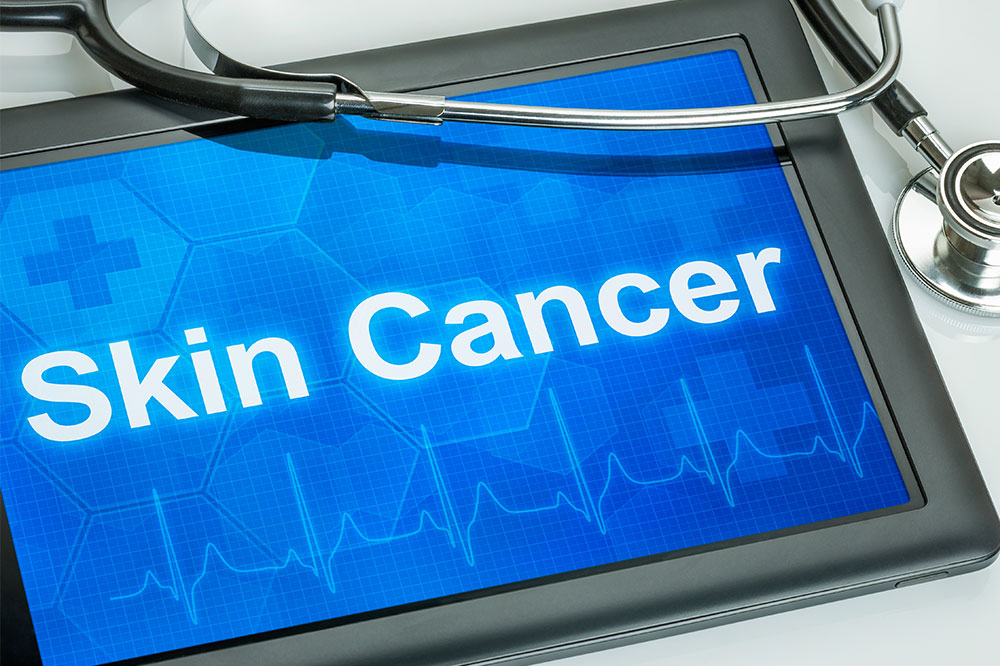Skin cancer – Types and warning signs

Skin cancer is the most common type of cancer. It often develops on areas of the skin that are constantly exposed to the sun. Depending on the cells they affect, there are three major types of skin cancer: basal cell carcinoma, squamous cell carcinoma, and melanoma. Each of these conditions may manifest differently. Knowing their warning signs can help one detect skin cancer early and manage it before it spreads.
Warning signs of basal cell carcinoma
This is the most common type of skin cancer. It forms in the basal cells of the skin, which lie at the bottom of the epidermis. It usually affects the sun-exposed areas of the body, such as the face and neck. Common signs and symptoms include a small pink or red bump that is shiny, pearly, or translucent and may have black, blue, or brown spots;
flat, flesh-colored, yellow, or brown scar-like lesion; lesions that bleed spontaneously without being irritated or picked; bleeding or scabbing open sore that doesn’t heal or heals and returns; pink growth with raised edges and a deflated center that may feature atypical blood vessels; and raised and itchy red patches.
Warning signs of squamous cell carcinoma
This is the second most common type of skin cancer, affecting over one million people yearly. It develops in the squamous cells, which are found near the skin’s surface. This may affect exposed and unexposed areas of the skin, especially among people with darker-colored skin. It may appear as a firm, red nodule; a flat lesion with a scaly, crusted surface; a rough, red scaly patch; an open sore with raised borders;
a wart-like growth; a sore that develops like an old scar; a horn-shaped growth; a hard lesion that doubles in size within weeks; and growths that spread to other parts of the body.
Warning signs of melanoma
Melanoma makes up 1% of skin cancer cases but causes the most deaths. It develops in the melanocyte cells, giving the skin its color or pigment. This form of skin cancer may develop anywhere in the body. Among men, it generally appears around their face or their trunks, while in women, it most commonly affects the lower legs. It can affect anyone, regardless of their skin color. Common signs and symptoms include a large brownish spot with darker speckles; a mole that changes in color, size, or feeling; a small lesion with an irregular border that appears red, pink, white, blue, or blue-black; a painful lesion that itches or burns; and dark lesions on the palms, soles, fingertips, or toes, or the mucous membranes lining the mouth, nose, vagina, or anus.
The ABCDE technique to recognize melanoma
Use the alphabet as a guide to detecting the advancement of melanoma in the body. Here’s what each letter represents:
- Asymmetry
Most melanomas are asymmetrical, such that the two halves do not look identical when divided in half. - Border
Melanoma borders are generally uneven and may have scalloped hems or edges. In comparison, regular moles have smooth and even-looking borders. - Color
Noticing multiple colors on the moles is also a warning sign for melanoma. Benign moles are usually a single shade of brown. However, a melanoma mole may appear in shades of tan, brown, or black. It may also appear red, white, pink, or blue as it grows. - Diameter/darkness
Lesions about 6mm or 1/4th of an inch in diameter or larger are major warning signs of melanoma. Keep an eye out for lesions that are darker than others. - Evolving
Any changes in the shape, size, color, or spot on the skin, or new symptoms such as bleeding, itching, or crusting, may be a symptom of melanoma.
Signs and symptoms of less common skin cancers
Here are some other warning signs of less common skin cancers to keep an eye out for:
- Kaposi sarcoma
Kaposi sarcoma is a type of cancer that forms in the lining of blood and lymph vessels. There are several warning signs to watch out for. These include flat, painless spots that may appear red, purple, blue, brown, or black; lesions in the mouth and throat, making it difficult to swallow; severe swelling in the arms, legs, face, or scrotum; chronic coughing and shortness of breath; and bleeding or blockages that cause an upset stomach, vomiting, belly pain, diarrhea, bloody or black stools, or anemia. - Merkel cell carcinoma
Merkel cell carcinoma looks harmless and may be mistaken for a mosquito bite, sore, cyst, or even a pimple. Watch out for a few ways it may appear on the skin. These include red, pink, or purple spots on the skin; a reddish, raised spot that looks like a sore; a fast-growing spot on the skin that may bleed at times; a firm, dome-shaped growth that increases rapidly; a painless stye or cyst, and a growing sore, spot, or mass on the skin. - Sebaceous gland carcinoma
This rare type of skin cancer begins in the oil gland, most commonly affecting the eyelids. Signs and symptoms to watch out for on the eyelids include a slowly growing yellowish lump that feels firm, deep, and painless; thickening of the eyelid where the lid meets the lash; a yellowish or reddish crust on the eyelid; growth on the eyelid that looks like a pimple; any bleeding growths on the eyelids; and sores on the eyelids that do not heal or heal and reappear.
On the rest of the body, sebaceous gland carcinoma may also appear as a new growth on the skin, eyelid, inside the ear, or as changing moles or spots.
If one notices any warning signs on their skin, it is time to get them checked out by a dermatologist. Early skin cancer diagnosis can pave the way for timely treatment, leading to a better quality of life.









